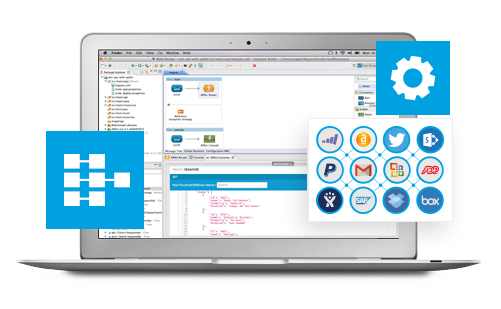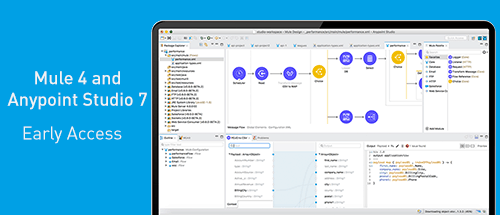
- One area that is still a bit weak is the download of additional jars. Right now the IDE 'knows' Mule's examples and the additional libraries to download. But I can think of a way to make this approach generic so that you can have Mule IDE download additional jars as part of creating a new Mule project from a template.
- This Tutorial video will provide you complete guide for downloading and startup the Anypoint Studio.
Now that we have created our MuleSoft account, let's developed the backend logic of the video game using Flow Designer. If you click the blue button below, you will be taken to the Mule Invaders Exchange page where you can download and modify the integration right in your web browser. When you navigate to Exchange by clicking the button below, click Open Flow to open up the integration in Design Center.
Anypoint Studio Install

Anypoint Studio is available in three versions: Windows, MAC and Linux OS. You can download MuleSoft from this link – Mulesoft Studio. Once you open the link, you will come across 'Download Studio' option. Click on that to head to the next page. Download for PC. Download for Mac. How was the game made? Mule Invaders was built using the Unity game engine and written entirely in C#. The video game client polls our API Endpoint created in Anypoint Platform and listens for any updated value in the Object Store. With Anypoint Platform®, MuleSoft delivers a complete integration experience built on proven open source technology, eliminating the pain and cost of point-to-point integration. Anypoint Platform includes CloudHub™ iPaaS, Mule ESB™, and a unified solution for API management™, design and publishing. ©2020 MuleSoft LLC, a Salesforce company.
Once you click Open Flow, you will need to click: Use this template which will import the entire project into your Anypoint Platform account. When you are prompted to provide a name for the Mule Applicaiton, name it: MuleInvaders.
When you click on the Use this template button, you will see some errors when loading the project. These errors are can be fixed easily! All you have to do is set up your HTTP Listener. An HTTP Listener is a very helpful Connector that enables you to listen to a URL for any new HTTP Request. When a new HTTP request is received by the HTTP Listener, anything that comes after the HTTP Listener in the flow will be executed at runtime.
To set up the HTTP Listener, click on cloudhub_http on the left navigation bar, and then click Add Connection. Insert the credentials listed in the screenshot below by adding the Host as 0.0.0.0 and the Port as 8081.
Once you have added the HTTP listener credentials, click Save and you will notice that all the errors in the project will disappear.
How does the Mule Application work?
In the video game Mule Invaders, there are four powerups that you can unlock in the actual game through sending an HTTP request to one of the API endpoints we have just created. The main endpoint, /hack is the main endpoint that the game client is listening too. The game detects when a new UUID has been added to the Object Store under that endpoints unique key. When a new UUID has been added, the powerup will spawn in the video game. This works since the game polls the /hack endpoint for any new update to the object store twice a second.
Here is a brief description of what each endpoint will do in the video game Mule Invaders:
/hack
This is the endpoint that the Mule Invaders client application listens to and polls to listen for a new update from the KV Store.
/spawnshield

SpawnShield gives the player invincibility for 5 seconds and protects the player from incoming vulnerabilities. You can see in-game that the text will flash 'protected by Anypoint Security' when the shield is spawned.
/powerlaser
PowerLaser gives the player a spread laser cannon that changes the particle to red and allows you to kill enemies faster.
/api-blaster
API Blaster increases the fire rate of laser cannons. Pew pew pew.
/spawnscore
Spawn score gives you bonus +1000 points and creates the slot machine sound effect.
Ready to play?
Now that you understand how the Mule application was built, and how each API endpoint affects the video game, go up to the top right of the Flow Designer window and click the Test button to try out the integration you just built.
Mulesoft Download Anypoint Studio
To test the integration, insert the mocking service URL into a REST client such as Postman, and make a POST request to the endpoint URL that you just created (don't forget to add /hack on the end of the URL). Once you make the HTTP request, you should see is a null value response for each JSON key in all request body. This is because we currently have no values added in the Object Store under those key names.
To add a new value to the Object Store, change your request URL to /spawnscore instead of /hack and send an additional POST request.

- One area that is still a bit weak is the download of additional jars. Right now the IDE 'knows' Mule's examples and the additional libraries to download. But I can think of a way to make this approach generic so that you can have Mule IDE download additional jars as part of creating a new Mule project from a template.
- This Tutorial video will provide you complete guide for downloading and startup the Anypoint Studio.
Now that we have created our MuleSoft account, let's developed the backend logic of the video game using Flow Designer. If you click the blue button below, you will be taken to the Mule Invaders Exchange page where you can download and modify the integration right in your web browser. When you navigate to Exchange by clicking the button below, click Open Flow to open up the integration in Design Center.
Anypoint Studio Install
Anypoint Studio is available in three versions: Windows, MAC and Linux OS. You can download MuleSoft from this link – Mulesoft Studio. Once you open the link, you will come across 'Download Studio' option. Click on that to head to the next page. Download for PC. Download for Mac. How was the game made? Mule Invaders was built using the Unity game engine and written entirely in C#. The video game client polls our API Endpoint created in Anypoint Platform and listens for any updated value in the Object Store. With Anypoint Platform®, MuleSoft delivers a complete integration experience built on proven open source technology, eliminating the pain and cost of point-to-point integration. Anypoint Platform includes CloudHub™ iPaaS, Mule ESB™, and a unified solution for API management™, design and publishing. ©2020 MuleSoft LLC, a Salesforce company.
Once you click Open Flow, you will need to click: Use this template which will import the entire project into your Anypoint Platform account. When you are prompted to provide a name for the Mule Applicaiton, name it: MuleInvaders.
When you click on the Use this template button, you will see some errors when loading the project. These errors are can be fixed easily! All you have to do is set up your HTTP Listener. An HTTP Listener is a very helpful Connector that enables you to listen to a URL for any new HTTP Request. When a new HTTP request is received by the HTTP Listener, anything that comes after the HTTP Listener in the flow will be executed at runtime.
To set up the HTTP Listener, click on cloudhub_http on the left navigation bar, and then click Add Connection. Insert the credentials listed in the screenshot below by adding the Host as 0.0.0.0 and the Port as 8081.
Once you have added the HTTP listener credentials, click Save and you will notice that all the errors in the project will disappear.
How does the Mule Application work?
In the video game Mule Invaders, there are four powerups that you can unlock in the actual game through sending an HTTP request to one of the API endpoints we have just created. The main endpoint, /hack is the main endpoint that the game client is listening too. The game detects when a new UUID has been added to the Object Store under that endpoints unique key. When a new UUID has been added, the powerup will spawn in the video game. This works since the game polls the /hack endpoint for any new update to the object store twice a second.
Here is a brief description of what each endpoint will do in the video game Mule Invaders:
/hack
This is the endpoint that the Mule Invaders client application listens to and polls to listen for a new update from the KV Store.
/spawnshield
SpawnShield gives the player invincibility for 5 seconds and protects the player from incoming vulnerabilities. You can see in-game that the text will flash 'protected by Anypoint Security' when the shield is spawned.
/powerlaser
PowerLaser gives the player a spread laser cannon that changes the particle to red and allows you to kill enemies faster.
/api-blaster
API Blaster increases the fire rate of laser cannons. Pew pew pew.
/spawnscore
Spawn score gives you bonus +1000 points and creates the slot machine sound effect.
Ready to play?
Now that you understand how the Mule application was built, and how each API endpoint affects the video game, go up to the top right of the Flow Designer window and click the Test button to try out the integration you just built.
Mulesoft Download Anypoint Studio
To test the integration, insert the mocking service URL into a REST client such as Postman, and make a POST request to the endpoint URL that you just created (don't forget to add /hack on the end of the URL). Once you make the HTTP request, you should see is a null value response for each JSON key in all request body. This is because we currently have no values added in the Object Store under those key names.
To add a new value to the Object Store, change your request URL to /spawnscore instead of /hack and send an additional POST request.
Mule Anypoint Studio Download Mac Installer
Now once again change your request URL back from /spawnscore to /hack again, and you will notice that score now has a UUID assigned under that JSON key.
This JSON payload is how the game is able to detect if a new request has been made. Pretty simple right?
Publishing your integration
Anypoint Studio Download Windows 10
Now that you understand how the Mule Application works, let's publish our application to CloudHub so we can get a dedicated URL for our application to run on. Click the drop-down arrow at the top right-hand side of the project and click the Deploy Application button. Select your target environment as Sandbox and name your application whatever you wish (must be a unique name). It will take a few minutes for your application to deploy, however when it finishes, navigate to Runtime Manager, then switch your environment to the one you selected which is Sandbox. The application should be illuminating a green dot stating that it is running. Click on the application, and grab the URL from the top of the page, copy it into your URL bar, and add http:// to the beginning and add the /hack endpoint to the end of the URL. That URL including the /hack endpoint will be the URL you insert into the video game.
